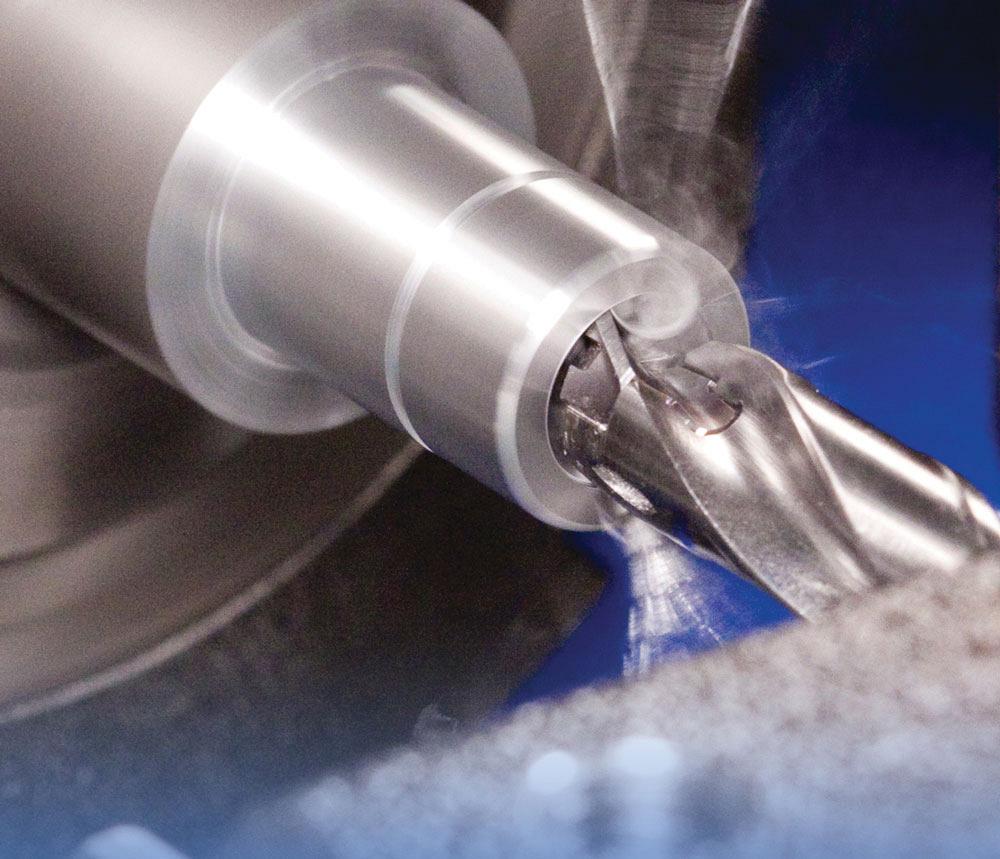Editor
- FMA
- The Fabricator
- FABTECH
- Canadian Metalworking
Large-hole repair requires technique, knowledge
Drilling hard steel means lowering speeds and feeds, using right geometry
- By Joe Thompson
- September 28, 2017
- Article
- Cutting Tools
It may not be often that you have to create a large-diameter hole in a hardened steel part, but when this situation arises, there are some rules that need to be followed.
Typically, large holes are created using indexable drills. Proper production planning, however, usually dictates that if a large amount of material needs to be removed, it should be done while the material is still in a softened state. Because this isn’t always possible, tools have been developed to cut these difficult-to-machine materials.
The ISO H group of material includes hardened steels with hardnesses between 45 and 68 HRC.
The cutting tool needs to have good resistance to plastic deformation, high mechanical strength, and abrasive wear resistance.
“Grades and coatings are both important and must be chosen to take into consideration the hardness of the material and the high heat that will be generated during the cutting process,” said David Vetrecin, holemaking product manager for Iscar Canada.
Cutting hardened material is tough on the cutting tool, and some trial and error may be necessary.
“A hard substrate may be too brittle when it comes in contact with a hardened piece of steel,” said Vetrecin. “In these cases, we would select a grade that is tough rather than one that is hard.”
“When drilling hardened steels, material strength is the first enemy,” explained Sarang Garud, product manager for Walter USA. “Large torque and thrust requirements make it challenging to remove large quantities of material in a single operation.”
Usually large-diameter holes are predrilled before the hardening of the material takes place. Machining in the hardened state often is reserved for a finish boring operation.
“Indexable drilling of holes is largely limited to repair and rework operations. Indexable drills are not used to drill materials beyond hardness of 57 HRC,” said Garud. “The range of 50 to 57 HRC also is a challenging range.”
Starting the Hole
When the tool first meets the workpiece, it’s always best to use a flat starting surface. Using a pilot hole strategy usually isn’t required because indexable drills aren’t used in deep-hole operations that sometimes require a pilot hole to be drilled.
As the hole begins to take shape, it’s important to utilize the correct feed rate and cutting speed.
“Feed rate should be sufficient enough to facilitate the chip breakage. Excessively small feeds lead to rubbing of the cutting edge and excessive tool wear, which is even further accelerated by hardness of materials. But with hardened materials, it is also important to avoid large feeds. With large feeds more material is being removed in the same amount of time, which means larger torque and thrust requirements,” said Garud.
Higher-than-necessary feeds also contribute to higher heat generation, something to avoid when cutting hardened materials.
“Feeds are usually 50 per cent lower than corresponding softened-state steels,” said Garud. “Beyond 50 HRC, every point of increased hardness brings new challenges. So feeds should drop down to as much as 20 per cent if the hardness of the material changes from 50 HRC to 57 HRC. Speeds are usually 25 to 30 per cent of the corresponding softened states of material.”
It’s common when cutting hard materials to keep speeds low.
“Rubbing is a characteristic of tool geometry. A larger clearance angle and sharper cutting edge usually are recommended to avoid rubbing,” said Garud.
Coolant Usage
Like for any operation that generates a high amount of heat, large-hole drilling requires using the proper coolant strategy.
“The coolant must be able to keep the work zone cool and flush the chips out of the hole,” said Vetrecin. “We recommend using as much coolant as possible in terms of volume and pressure to keep the cutting area stable and avoid the re-cutting of chips.”
Because hardened steels typically are good chipping materials (materials that produce small, easily managed chips), coolant is mainly used as a means to prolong tool life.
“Heat always plays a factor when you are cutting hard materials,” said Vetrecin. “Anything we can do to keep that heat away from the substrate, whether that’s using coolant or selecting the right coating for the tool, will yield better tool life.”
Editor Joe Thompson can be reached at jthompson@canadianmetalworking.com.
Iscar Canada, 905-829-9000, www.iscar.ca
Walter USA, 800-945-5554, www.walter-tools.com
About the Author

Joe Thompson
416-1154 Warden Avenue
Toronto, M1R 0A1 Canada
905-315-8226
Joe Thompson has been covering the Canadian manufacturing sector for more than two decades. He is responsible for the day-to-day editorial direction of the magazine, providing a uniquely Canadian look at the world of metal manufacturing.
An award-winning writer and graduate of the Sheridan College journalism program, he has published articles worldwide in a variety of industries, including manufacturing, pharmaceutical, medical, infrastructure, and entertainment.
Related Companies
subscribe now


Keep up to date with the latest news, events, and technology for all things metal from our pair of monthly magazines written specifically for Canadian manufacturers!
Start Your Free Subscription- Industry Events
Automate 2024
- May 6 - 9, 2024
- Chicago, IL
ANCA Open House
- May 7 - 8, 2024
- Wixom, MI
17th annual Joint Open House
- May 8 - 9, 2024
- Oakville and Mississauga, ON Canada
MME Saskatoon
- May 28, 2024
- Saskatoon, SK Canada
CME's Health & Safety Symposium for Manufacturers
- May 29, 2024
- Mississauga, ON Canada






















